#Advent with the Pythons
Explore tagged Tumblr posts
Text
1. Advent Sunday - Imagine

"Now the Christmas season truly has begun!", Eric exclaimed with a chuckle while he set a small but heavy box down on the table. Thud. "Careful!", you quickly warned. "Think of all the delicate ornaments."
Gently and with a hint of childlike excitement you lifted off the box's lid. It was fillled to the brim with all kinds of Christmas decorations and essentials, the ornaments sparkling slightly in the light. "Have fun sorting through that mess… Do we really need all those things?" Terry Gilliam chimed in, leaning over the table to get a better glance at the contents of the box. You playfully tsk-ed at him, shaking your head dismissively. "Terry, Terry, Terry… Says the man from the country of extensive Christmas decorations…"
While you and Terry were occupied playfully bickering with each other, Eric had summoned the courage to reach into the gathering of all things Christmas. With an amused expression he pulled out an ornament in form of a santa hat wearing goose, holding it up between his fingers like a tiny artifact. "Think of it differently, Terry. We have the wonderful gift of not having to go shopping for any decoration this year - we've already got everything", he said with his usual lighthearted joking tone, pulling the others' attention back towards the box.
You looked over at him, taking a second to realize what he was going at now. Seeing it was your beloved goose ornament he was taking a jab at, you huffed slightly. "Oh come on… We're not decorating the tree yet. We just need the stuff for the Advent wreath." You now dove into the box as well, carefully digging through wooden figurines, glass ornaments and tinsel before taking out a few gold painted pine cones and lining them up on the table. "Look. Is this more to your liking?", you asked Eric, challenging him. "Brings you the true spirit of Christmas!" It was Terry who answered instead, holding back a cordial laugh.
"All it is is bloody cold, really…" You turned your head towards the door through which the other Terry joined you with a friendly smile and arms full with four big candles. You quickly hurried over to him to help him with the candles. "Well observed, Tel." Eric took a glance out of the window, where frost covered the trees and plants. "Everything's white, yet it can't even be bothered to be snow…"
"You all don't have to worry about going out anyway, dear Eric…" This time it was John, coming through the door and bringing with him the faint smell of coldness from outside. "We're gonna be fairly busy with crafting this wreath all day. We should have probably just bought a ready made one but this is what happens when you listen to Y/N's ideas…" He was carrying a bunch of evergreen branches, adding them to the christmassy chaos of box, golden pine cones and candles on the table. The small but warm grin he gave you told you that he wasn't actually annoyed, though.
"It's just a completely different feeling if you do it yourself! You'll see...", you quickly promised with a wide smile before you ushered them all towards the table to start your work on the Advent wreath.
[This was an extremely spontaneous idea and i just wrote it down as it came to my mind. Idk how accurate this is when it comes to British Christmas traditions as I basically just pulled the Pythons into my own (non-british) experiences. But i hope you enjoyed reading it anyway ♡]
#Advent with the Pythons#By the way - Michael and Graham might appear in the next weeks too#but i can't promise anything#And god knows why you live together with Eric; John and the Terrys#monty python fanfiction#eric idle#john cleese#terry gilliam#terry jones#christmas special#fanfics
10 notes
·
View notes
Text
I did a 25-recipe Christmas advent calendar last year, this year I've made it into a cookbook!
Includes 25 Holiday-appropriate recipes ranging from simple to complicated and sweet to savory, treats and full dinners that you can prepare on the lead-up to Christmas!
4 notes
·
View notes
Text
Advent of Code 2024 - Day 06 - Guard Gallivant
Its happening already. The slow crushing creep of lazyness. I have not done part 2, yet, and I will, maybe get to it. I have ideas for how to solve part 2, its just… Kind of tedious and I want a respite. Part 1 was fun though. Basically just, a simple pathfinding robot to trace the path of a guard through a maze of obstacles. I even gave it the ability to draw the map, but the dataset is bigger…
0 notes
Text
the first rule of using pointers is have fun and be yourself
#been doing some definitly unsafe shit for advent of code#didnt want to do propper bounds checking today so my solution relies on the fact that the data is 140x140 and my matrix is 150x150#yesterday was a little odd aswell cause i was doing like pattern matching without regex#don't think my solution was super unsafe or anything but pointer arithmetic is not something ive done in the past really#tried re-writing it w/ regex (in C) but i discovered the hell that is different regex versions#spent way too long figuring out how regex.h (POSIX regex lib) worked only to discover that POSIX regex is like... not very good...#like posix regex doesnt even have non-capturing groups???#(and regex101.com doesnt support POSIX ere/bre)#ended up writing a pretry swanky solution w/ regex in python and someone in my school's AOC discord put it in a oneliner lol
0 notes
Text
Horse Story #2 for @elodieunderglass
Me and the KGB In 1984, the Summer Olympics were being held in Los Angeles. The Soviet Union and Eastern Bloc countries all boycotted the Olympics, and held their own event -- The Friendship Games -- in the Soviet Union.
At 14, I was too young for the Olympic team, so my horse Michael and I headed off for Sopot in Poland, where the equestrian events for the Friendship Games were being held. On the interminable plane ride, all the athletes were given a briefing by the CIA. We were told that everywhere we went, there would be KGB officers, that we could not talk to athletes from the Eastern Bloc or they could be hauled away and interrogated or imprisoned. We were told that there would be listening devices, undercover agents, all that cold war spy stuff. We were ordered to act with all decorum, to take the security situation with the utmost seriousness, to not provoke the KGB in any way. Those of you who have read my previous story can see that this is all going to end poorly. As a bratty, rage filled teenager, there was no decorum in me. I was determined that if the KGB was going to spy on me, I'd give them plenty to keep them busy. (I would like to pause here and state that I am deeply sorry to the people of Russia and Poland for my lack of respect and maturity. To all the KGB officers who were involved: go fuck yourselves with angry hedgehogs, sideways.)
At the hotel, we could easily spot the KGB agents...they always stood in groups of three. The logic went that one agent couldn't be trusted, two could conspire, but in groups of three one would always snitch. Our rooms were searched, clumsily, on an almost daily basis. Our rooms were bugged. At the stables, there were KGB clusters everywhere, and it was clear that the stablehands were almost all spies, as they seemed to have no clue how to clean a stall and spent most of their time lurking. 14 year old me found this hilarious, and I soon cajoled one of the other young American riders to join me in harassing the KGB mercilessly, for funsies. I had read somewhere that non-native English speakers found certain English word games incomprehensible, so my friend and I spent that week only speaking in Pig Latin. This was harmless fun. On the second day, however, our tack room had been searched, and it was clear that the KGB had taken souvenirs for themselves. This pissed me off. Boris the KGB agent who had been assigned to us was a horrible man...slimy, smarmy, shifty. He leered a lot. He smelled like spoiled milk and bad cheese. He would try to sidle up to us and brush against us 'by accident.' I immediately suspected he was the one who had stolen our things, including one of my sports bras. I wanted to hurt him. My prized possession at the time was my brand new Walkman tape player, with the supercool spongy headphones. Whenever Boris was around, I would ostentatiously 'sneak' into my horse's stall, huddle in the corner, and pretend to hold whispered conversations with my Walkman, as if I were receiving instructions. Boris was all aquiver...he was convinced he had unearthed a spy ring. He tried to grab my Walkman, and I ducked around him and 'hid' it in the straw at the back of my horse's stall. My horse Michael was a nightmare. He was an enormous liver chestnut gelding, crazed, full of rage and spite and strange appetites. In all the world, the only thing he loved was jumping. He hated everything and everyone, and would have happily set the world on fire if only he had had thumbs. His hobbies were kicking and biting, and pursued those with an unholy zeal that was unmatched until the advent of Taylor Swift fans. Boris knew nothing about horses. So he marched up to the stall and fumbled with the latch. And 17 hands of psychotic Thoroughbred lunged from the shadows, unhinged his jaw like a giant python, and sank his teeth into Boris's shoulder. Boris let out a shrill, high pitched scream of panic and tried to pull back, but Michael would not let go. The barn aisle was suddenly full of KGB agents, shouting in Russian. Michael clamped down harder. I stood there, laughing hysterically. After probably too many moments, I pried Michael's jaws open, and Boris was led away, never to be seen by us again. A Strongly Worded Letter was sent to our embassy, and Michael and I were banned from ever again entering the Soviet Union or any of its client states. ------------------------------------------------------------------------------ If you enjoy my stories, please share my pinned post or buy me a Kofi. We are going through The Horrors, and all help is most truly appreciated. https://ko-fi.com/idiomagic
#horse stories#horses#international incident#Michael stories#please reblog#mutual aid#horse story number 2#michael the horse
503 notes
·
View notes
Text
Programming Languages and the Evolution of Programming in the Modern Era: A Philosophical Perspective 💻🤔
In the ever-changing world of technology, programming languages have become more than just tools; they are the very fabric upon which our digital existence is built. These languages, with their syntax and rules, hold within them the essence of human creativity, logic, and ambition. But what do these languages represent beyond their technical functions? What philosophical meaning can we derive from the evolution of programming, a field that reshapes the world in real-time?
The Birth of Logic: Philosophy Embedded in Code 🌱💡
At their core, programming languages are an attempt to communicate with the machine, to bridge the gap between human thought and computational execution. Just as language is the foundation of human interaction, programming languages are the foundation of our digital interaction with the world. The creation of each new programming language reflects a deeper philosophical question: How can we express the complexity of human ideas, emotions, and aspirations in a way that a machine can understand and execute?
The first programming languages, like assembly and machine code, were direct and precise, much like the early philosophies of existence: straightforward, logical, yet inherently limited by their inability to evolve beyond rigid forms. With the advent of higher-level languages like C and Python, there was a shift,a desire to express not just functionality but human complexity and adaptability.
These languages began to embrace abstraction, allowing us to express ideas in simpler terms while maintaining the richness of complexity.
Programming as a Language of Thought 🧠💭
Programming languages are, in a sense, a mirror of the human mind. Just as philosophers argue that language shapes thought, programming languages shape the way we perceive and interact with the digital world. As we moved from procedural programming to object-oriented programming (OOP), we began to reflect the complexity of the real world, organizing our ideas into classes and objects, building relationships between them, just as humans build connections in their society.
The very evolution of programming languages mirrors the evolution of human thought,from simple commands to complex algorithms that can adapt to an ever-changing digital landscape.
OOP represents a philosophical leap in how we conceptualize the world: not as a series of discrete, isolated events, but as a dynamic web of relationships. It is a reflection of how we understand existence itself,not as static or rigid, but as ever-evolving and interconnected.
The Question of Artificial Intelligence and Human Nature 🧬⚙️
As programming evolves, particularly with the rise of AI and machine learning, the philosophical question becomes: Can a machine, driven by code, truly understand or replicate human thought and creativity?
Are we approaching the point where the distinction between human and machine blurs, where programming languages will no longer be mere tools but entities that shape our very existence?
This is where philosophy meets reality,machines are not just executing instructions; they are learning, adapting, and possibly one day, thinking.
The rapid growth of AI forces us to reconsider what it means to be human. In programming these machines, we are attempting to teach them our way of thinking, our logic, our creativity. But as we impart our intelligence into machines, we are confronted with the notion that perhaps we are not teaching them our intelligence but creating a new kind of intelligence altogether. What, then, does it mean to "program" this intelligence? Is it an extension of our will, or does it transcend our own understanding?
Programming as Philosophy in Action 🧑💻⚖️
In the modern era, programming is no longer just a technical pursuit; it is philosophy in action. Every line of code written, every algorithm developed, is an exploration of ideas,of how we understand and define the world. Through programming, we engage in the philosophical task of trying to translate the abstract into the concrete, the unknown into the known. The choices made in the development of programming languages reflect broader philosophical trends: the shift from determinism to autonomy, from static systems to dynamic adaptability, from mere tools to extensions of human thought.
Each new programming language, each new framework, embodies an idea,a worldview, a vision of how humans can interact with machines, and ultimately with each other. Whether it is the simplicity and elegance of Python or the power and complexity of C++, we are not just using these languages to command machines; we are using them to express the essence of what it means to create.
As we look toward the future of programming, we must ask ourselves: Where does the evolution of code lead? Will it be a tool for creating increasingly complex and autonomous systems, or will it lead us toward a new philosophical frontier,where machines are not only functional tools but collaborators in the creative process? As we continue to develop programming languages, we are not just writing code for machines,we are, in a sense, writing the future of human creativity itself.
In the end, programming languages are more than just technical languages; they are expressions of our collective philosophical journey toward understanding ourselves and the digital world around us. They are the modern day equivalents of the ancient languages of thought, logic, and creation. And as we continue to evolve them, we continue to evolve ourselves. 🧑💻💭
#ella em#writing#a writer's life#thought#vivididreams#artists on tumblr#vividi#my writing#my blog#eslam elkhatim#vivididream#creative writing#writings#writer#writers on tumblr#writeblr#writers and poets#writerscommunity#writer on tumblr
7 notes
·
View notes
Text
Personal update 😃
I have not done a personal update for quite some time, so here it is! Today, I dreamed that it was suddenly the 1st of December and I had nothing prepared for my advent calendar yet and was feeling in over my head and thinking "Do I really want to do this again?!" Maybe my brain telling me to actually prepare patterns ahead of time this year and to start early? 🤔 I'll keep that in the back of my mind. I actually finally got Sims 4 running (let's see how long until the next patch breaks everything, maybe I have a few days left). I only want to play with tons of mods, which break all the time and are a pain to update, so I only do that procedure once or twice a year. When I actually get to play, I really like to immerse myself for a while until it is all over again. The funny thing is that I actually have fun playing because so many aspects are new to me (having fun in TS4 is almost unheard of, but apparently it can really happen 😆). Building and CAS are so much fun too! I'm not exactly a gameplay blog and not sure how many of you want to see TS4 on here anyway, so I doubt there will be many pics. I get super frustrated whenever I try to make sims in TS3 CAS, I guess I do not have some of y'all skills or the right CC at times (or do not know how to use it properly). In Sims 4, everything can be solved with a few skin overlays and I feel the weird head shape proportion thing that is so off in Sims 3 does not apply there, which makes everything easier. I do miss patterns though 🥲 I have been pretty preoccupied with other hobbies lately, I've been on a serious style rediscovery with my best friend, we discovered this style system called the Style Key and it is all about giving yourself permission to try out new things and your personal needs when choosing styles, which is really refreshing to all the systems that tell you "you cannot wear that with your body type!" So I've been trying things I did not actually dare to wear, like cute/playful outfits in pastel shades. I may wear the styles now that teenage me was too shy to wear and it feels great! I do not care anymore what other people may think about it. I recently discovered those colorful chunky plastic rings which surprisingly look good on me. I always felt like I could never really make jewelry work on me, and tried the tiniest minimalist pieces because everything felt "too much", but I have never tried the other extreme, the big chunky stuff because I told myself "that could never work". Turns out that trying out stuff instead of limiting myself feels really great and yields surprising results! And I feel more confident too because my outfits are fun and make me happy, and I am more relaxed if I feel happy too. In the Style Key system, I think I'm a Ruby (left-down quadrant) and I think the archetype "Spicy Girl Next Door" fits pretty nicely for me. The biggest takeaway for me is the realization that outfits have to "feel right" for me, not for anybody else and I do not dress to please anyone, but to help me feel good in my own skin and take into account my comfort needs and feelings on that day when I choose what to wear. The Style Key is not a system that tells you exactly what to wear, but it helps you figure out what you need your style to do for you and go from there. It's a bit daunting to get into because it is really so different from other systems and includes rather abstract theory/unusual concepts that are not really that intuitive, but the videos on the youtube channel really help to explain those concepts.
I also still work on some Python projects, but they're still a long way off from amounting to anything. But it's where I can use my problem-solving skills and just tinker around. I just really need something to bite my teeth into every now and then and that is perfect for it. 😊
16 notes
·
View notes
Text
Top 5 Programming Languages to Master in 2025
Programming language theory is the subfield of computer science that studies the design, implementation, analysis, characterization, and classification of programming languages.
1. Java
You might ask, “Is Java obsolete?” Of course not.
Why is Java still popular? Java is one of the oldest and most robust programming languages. It is also an object-oriented language mainly used for Android application development. This is one of the main reasons it is still used today. However, with the advent of programming languages like Kotlin (also suitable for Android development), Java is becoming less popular.
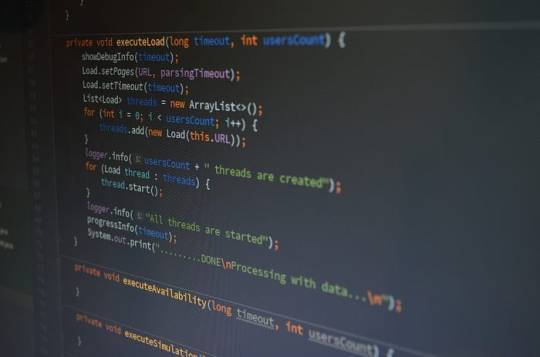
2. Swift

3. SQL

4. JavaScript

5. Python

The amazing thing about Python is that it’s a general-purpose programming language used to build a wide range of applications. Furthermore, it is active in artificial intelligence. Self-driving cars, Wal-Mart auto-payment, and many automation and machine learning (ML) apps were developed through Python. This makes this language more important and rapidly popularizes. In addition, Python is easier to learn than all other languages and is easy for beginners. You can also build complex applications relatively easily and quickly. In the United States, the average salary for Python developers is about $ 78,000, while experienced developers can be as high as $ 122,000.
2 notes
·
View notes
Text
My iPod FOR SALE!!
Posted: September 11, 2007 Archived from BonnyTymePyrate’s Journal Archives
eBay. It’s bourgeois. It’s a rip-off. It’s garishly designed It’s the temporary home of my iPod!!!!!
You read correctly! With the advent of the iPhone, I will no longer require the services of my trusty iPod a.k.a. Mr. Brigglesby to sustain me on those all-day-all-night road trips from country to country to country and back again. He’s seen some great times though…pit-stops in Vienna…cathedrals in Cologne…sleeping in Scotland (he steals the covers). He knows my ins-and-outs, he’s great at shuffling, and he knows exactly what song to play to put me right back into a bad mood when I’m starting to feel just a little too happy.
And now, he can do it for YOU!
Proceeds from the sale of my iPod will go towards crack and prostitutes, and believe me, between me and the Crumpets, we go through a lot of both. Anyway! Whatever is left after the crack and hos will go towards the purchase of fancy new fabrics for our stage costumes for the upcoming Winter Asylum Tour, crafted for your viewing pleasure! And, oh, won’t you feel special knowing you helped to make them…
BID on Mr. Brigglesby HERE:
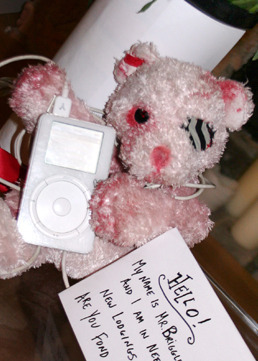
Here are the specs, bitches: Bloody Massive, SIGNED by MEEEE, 20 Gig Pod, Updated Software Black & White Light-Up Screen (no color, no video) Can be used as a hard drive No health issues, works like it did the day it was born The usual scratches in the metal backing, no dents, just normal cosmetic wear that tells you it’s been looooved… Any other questions, please ask via the eBay site, because even though eBay eSucks, you’ll get your question answered faster than you will here, where you most certainly won’t get a response in time because I am working sleeplessly and living in a cave. Includes: 1. USB cable (powers directly from your computer) 2. A personal note of introduction from Mr. Brigglesby to you 3. What about earbuds? FUCK no, it doesn’t come with my earbuds/phones/whatevers, because that would be disgusting and unsanitary, and you don’t want my ear-germs anyway, because even though I think I’m clean, I’ve never been tested, so let’s just not chance it, ok? EXTRAS: Here’s the fun part!! 1. GIGS of music already loaded (delete it if you hate metal) including: MY COMPLETE RECORDED CATALOG (Opheliac Double Disc, Liar/Dead EP, Laced/Unlaced, Enchant Rerelease, A Bit O’ This And That, Saw 3 Soundtrack), Angelspit, ASP, The Beatles, Bjork, Blutengel, The Chamber, Children Of Bodom, Cinema Strange, David Bowie, Dimmu Borgir, Dope Stars Inc., Dragonforce, Dreamtheatre, Einsturzende Neubauten, Finntroll, Flaming Lips, Gackt, Batman Begins Soundtrack, Harry Potter and the Prisoner of Azkaban Soundtrack, Jeff Buckley, The Killers, MaIice Mizer, Ministry, Moi dix Mois, Monty Python, Peter Murphy, Morrissey, The Smiths, Prodigy, Psyclon Nine, Queen, Rammstein, Schwarz Stein, Sex Pistols, The Shins, Sigur R�s, Steve Vai, Telepopmusik, Van Halen, Velvet Acid Christ, X Japan, and of course, Yngwie Malmsteen…AND MORE!!! *** MAKE MR. BRIGGLESBY YOUR BITCH TODAY! *** Final Note: I bought myself flowers today as a reward for never having bought myself flowers before. I was very grateful. Perhaps now I should go out drinking, come home late, and make myself sleep on the couch. Love & Bloody Crumpets from the Asylum for Wayward Victorian Girls, EA
6 notes
·
View notes
Text
From Curious Novice to Data Enthusiast: My Data Science Adventure
I've always been fascinated by data science, a field that seamlessly blends technology, mathematics, and curiosity. In this article, I want to take you on a journey—my journey—from being a curious novice to becoming a passionate data enthusiast. Together, let's explore the thrilling world of data science, and I'll share the steps I took to immerse myself in this captivating realm of knowledge.
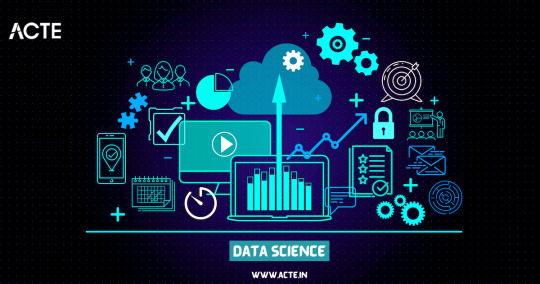
The Spark: Discovering the Potential of Data Science
The moment I stumbled upon data science, I felt a spark of inspiration. Witnessing its impact across various industries, from healthcare and finance to marketing and entertainment, I couldn't help but be drawn to this innovative field. The ability to extract critical insights from vast amounts of data and uncover meaningful patterns fascinated me, prompting me to dive deeper into the world of data science.
Laying the Foundation: The Importance of Learning the Basics
To embark on this data science adventure, I quickly realized the importance of building a strong foundation. Learning the basics of statistics, programming, and mathematics became my priority. Understanding statistical concepts and techniques enabled me to make sense of data distributions, correlations, and significance levels. Programming languages like Python and R became essential tools for data manipulation, analysis, and visualization, while a solid grasp of mathematical principles empowered me to create and evaluate predictive models.
The Quest for Knowledge: Exploring Various Data Science Disciplines
A. Machine Learning: Unraveling the Power of Predictive Models
Machine learning, a prominent discipline within data science, captivated me with its ability to unlock the potential of predictive models. I delved into the fundamentals, understanding the underlying algorithms that power these models. Supervised learning, where data with labels is used to train prediction models, and unsupervised learning, which uncovers hidden patterns within unlabeled data, intrigued me. Exploring concepts like regression, classification, clustering, and dimensionality reduction deepened my understanding of this powerful field.
B. Data Visualization: Telling Stories with Data
In my data science journey, I discovered the importance of effectively visualizing data to convey meaningful stories. Navigating through various visualization tools and techniques, such as creating dynamic charts, interactive dashboards, and compelling infographics, allowed me to unlock the hidden narratives within datasets. Visualizations became a medium to communicate complex ideas succinctly, enabling stakeholders to understand insights effortlessly.
C. Big Data: Mastering the Analysis of Vast Amounts of Information
The advent of big data challenged traditional data analysis approaches. To conquer this challenge, I dived into the world of big data, understanding its nuances and exploring techniques for efficient analysis. Uncovering the intricacies of distributed systems, parallel processing, and data storage frameworks empowered me to handle massive volumes of information effectively. With tools like Apache Hadoop and Spark, I was able to mine valuable insights from colossal datasets.
D. Natural Language Processing: Extracting Insights from Textual Data
Textual data surrounds us in the digital age, and the realm of natural language processing fascinated me. I delved into techniques for processing and analyzing unstructured text data, uncovering insights from tweets, customer reviews, news articles, and more. Understanding concepts like sentiment analysis, topic modeling, and named entity recognition allowed me to extract valuable information from written text, revolutionizing industries like sentiment analysis, customer service, and content recommendation systems.
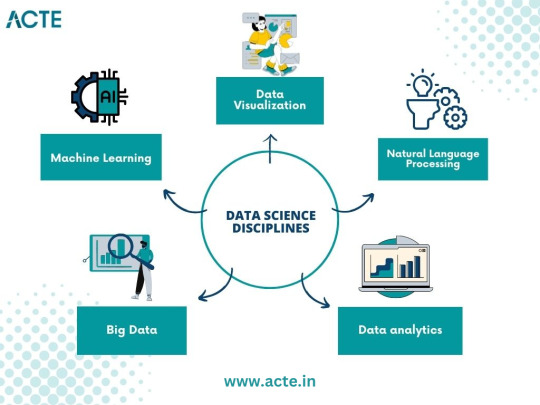
Building the Arsenal: Acquiring Data Science Skills and Tools
Acquiring essential skills and familiarizing myself with relevant tools played a crucial role in my data science journey. Programming languages like Python and R became my companions, enabling me to manipulate, analyze, and model data efficiently. Additionally, I explored popular data science libraries and frameworks such as TensorFlow, Scikit-learn, Pandas, and NumPy, which expedited the development and deployment of machine learning models. The arsenal of skills and tools I accumulated became my assets in the quest for data-driven insights.
The Real-World Challenge: Applying Data Science in Practice
Data science is not just an academic pursuit but rather a practical discipline aimed at solving real-world problems. Throughout my journey, I sought to identify such problems and apply data science methodologies to provide practical solutions. From predicting customer churn to optimizing supply chain logistics, the application of data science proved transformative in various domains. Sharing success stories of leveraging data science in practice inspires others to realize the power of this field.
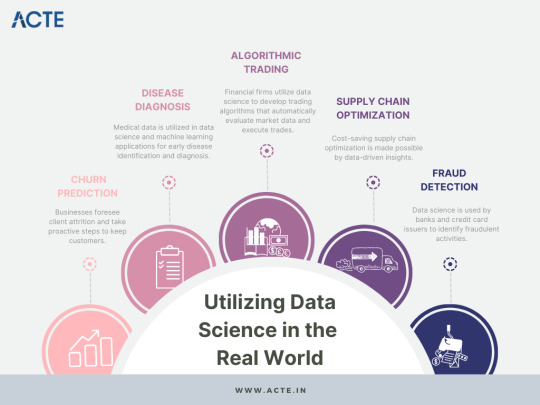
Cultivating Curiosity: Continuous Learning and Skill Enhancement
Embracing a growth mindset is paramount in the world of data science. The field is rapidly evolving, with new algorithms, techniques, and tools emerging frequently. To stay ahead, it is essential to cultivate curiosity and foster a continuous learning mindset. Keeping abreast of the latest research papers, attending data science conferences, and engaging in data science courses nurtures personal and professional growth. The journey to becoming a data enthusiast is a lifelong pursuit.
Joining the Community: Networking and Collaboration
Being part of the data science community is a catalyst for growth and inspiration. Engaging with like-minded individuals, sharing knowledge, and collaborating on projects enhances the learning experience. Joining online forums, participating in Kaggle competitions, and attending meetups provides opportunities to exchange ideas, solve challenges collectively, and foster invaluable connections within the data science community.
Overcoming Obstacles: Dealing with Common Data Science Challenges
Data science, like any discipline, presents its own set of challenges. From data cleaning and preprocessing to model selection and evaluation, obstacles arise at each stage of the data science pipeline. Strategies and tips to overcome these challenges, such as building reliable pipelines, conducting robust experiments, and leveraging cross-validation techniques, are indispensable in maintaining motivation and achieving success in the data science journey.
Balancing Act: Building a Career in Data Science alongside Other Commitments
For many aspiring data scientists, the pursuit of knowledge and skills must coexist with other commitments, such as full-time jobs and personal responsibilities. Effectively managing time and developing a structured learning plan is crucial in striking a balance. Tips such as identifying pockets of dedicated learning time, breaking down complex concepts into manageable chunks, and seeking mentorships or online communities can empower individuals to navigate the data science journey while juggling other responsibilities.
Ethical Considerations: Navigating the World of Data Responsibly
As data scientists, we must navigate the world of data responsibly, being mindful of the ethical considerations inherent in this field. Safeguarding privacy, addressing bias in algorithms, and ensuring transparency in data-driven decision-making are critical principles. Exploring topics such as algorithmic fairness, data anonymization techniques, and the societal impact of data science encourages responsible and ethical practices in a rapidly evolving digital landscape.
Embarking on a data science adventure from a curious novice to a passionate data enthusiast is an exhilarating and rewarding journey. By laying a foundation of knowledge, exploring various data science disciplines, acquiring essential skills and tools, and engaging in continuous learning, one can conquer challenges, build a successful career, and have a good influence on the data science community. It's a journey that never truly ends, as data continues to evolve and offer exciting opportunities for discovery and innovation. So, join me in your data science adventure, and let the exploration begin!
#data science#data analytics#data visualization#big data#machine learning#artificial intelligence#education#information
17 notes
·
View notes
Text
Advent of code day 1 done in Python. Still need the C++ solution. The part two is kinda annoying here though as I used Python in mind first. I don't know if using string find is a good idea? For first digit yes, for last though...
2 notes
·
View notes
Text
Advent of Code 2024 - Day 05 - Print Queue
Well, it’s an easy and hard-ish day. I kind of hate the part 2s on these because they are almost always annoying. It was a bit more interesting on the input because it was a two part input. I’m still getting weird empty spaces at the end too, which I have just been trimming with a .pop(), but that’s a bit sloppy. Today’s puzzle is verifying sorting of sets of numbers. Part 1 was pretty…
0 notes
Text
More tags, adding on more length to this post (I hope this doesn’t become the new “do you love the color of the sky”)

You may be thinking of minks, which are another type of mustelid related to ferrets. Minks are bred in fur farms and fur farm minks are larger and softer than wild minks. Since they’re bred in human care, they do tend to be much tamer than a wild mink would be, however, they are not truly domesticated. They’re bred for size, color, softness, and ease of care in a fur farm setting, not for ease of care in a person’s house. Still, some people keep them as exotic pets. As they are semi-aquatic, they require access to water deep enough to submerge in at all times, a varied diet, and a rigorous enrichment program. These are things that can not be provided by a single household. I agree with your friend, if they were in fact talking about minks! If not though, ferrets are good alternative pets to keep but definitely require a specific type of person able to keep up with their enrichment needs and diet, as you’re probably not going to be using them to hunt rabbits.

No, it can take hundreds of generations for an animal population to have evolved enough to be considered domesticated. What you are thinking of is habituation. Habituation involves training an animal (whether intentionally or not) to lose its fear of humans. This is incredibly dangerous for the animal. Some habituated animals end up in zoos, but most end up needing to be euthanized for both the animals’ safety and human safety. It also leads to the spread of zoonotic diseases such as rabies and toxoplasmosis. I really hope you’re joking about luring foxes into your home.

Siberia is in Asia, and from what I read while researching for this, most can agree that dog domestication happened somewhere around there. I’m sure it would have been more Northern, as that’s where Pleistocene Wolves would have been ranging.
I don’t think we can truly ever get an exact area though. All the other animals on this list were domesticated during or after the advent of civilization. Dogs were domesticated when humans were still migratory hunter-gatherers, which is just wild to me.

There is actually a type of sheep called the European Mouflon, which were descended from feral sheep (similar to how wild hogs are descended from feral pigs). I worked with some at one point and they are insane. I can not imagine how the first round-up of truly wild Armenian Mouflon went.

Thank you for pointing this out it’s literally my favorite scientific name

I would be up for it as long as any educators contact me first, after which I can send them the high-res images. I don’t like my stuff being used without permission. I’d also want some time to correct issues I’m already noticing (I forgot to add blood sport for chickens and also the afformentioned misleading way I seemed to include spider ball pythons as a breed rather than an example of unethical breeding).

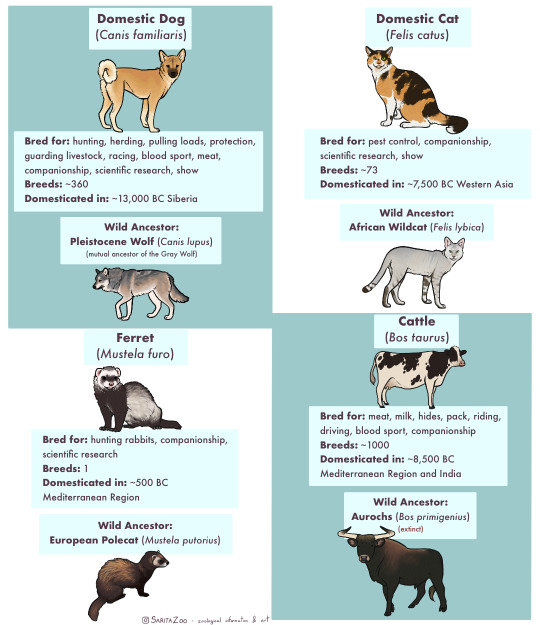


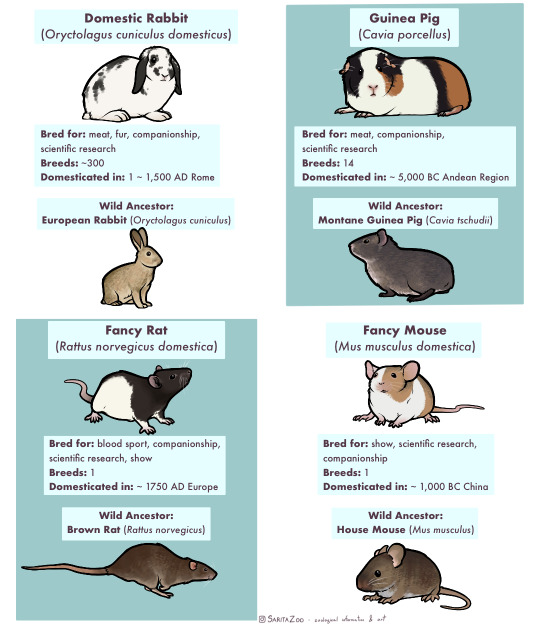
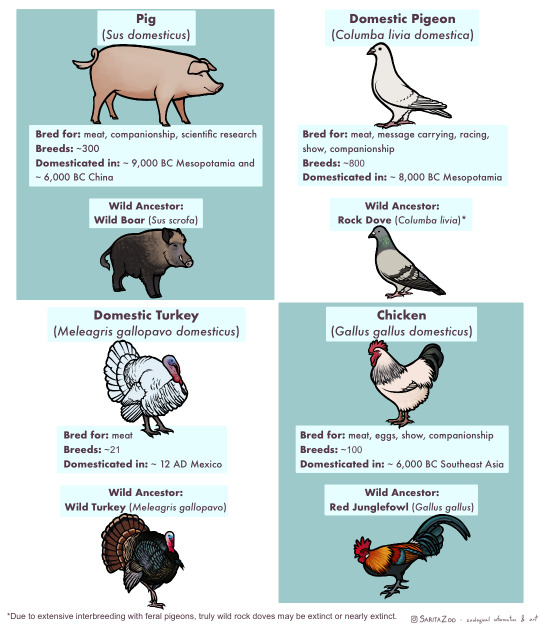
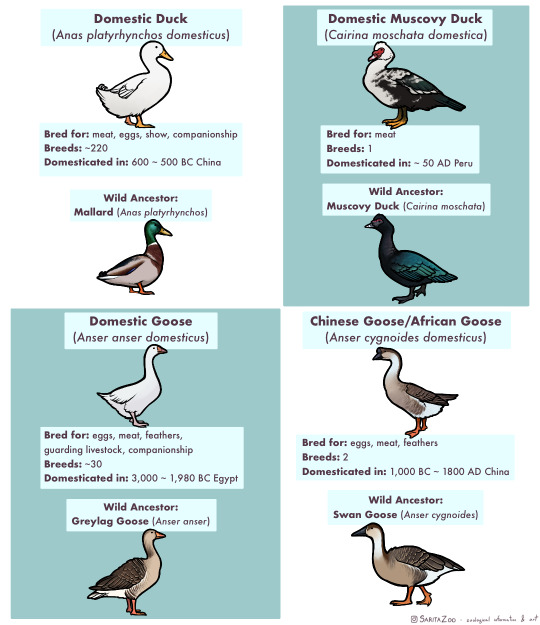
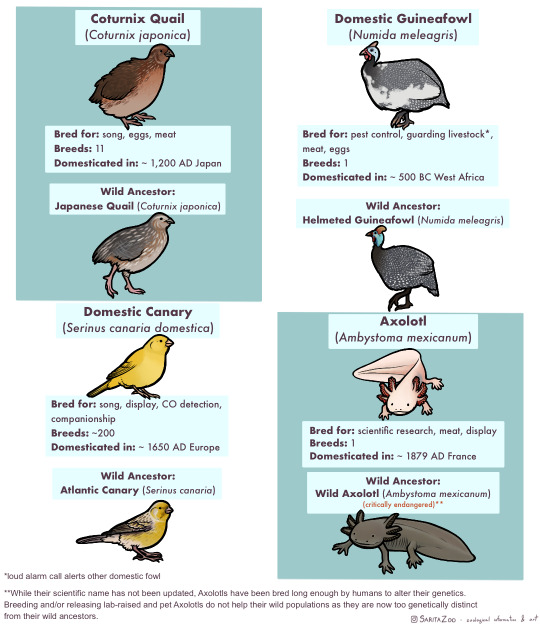
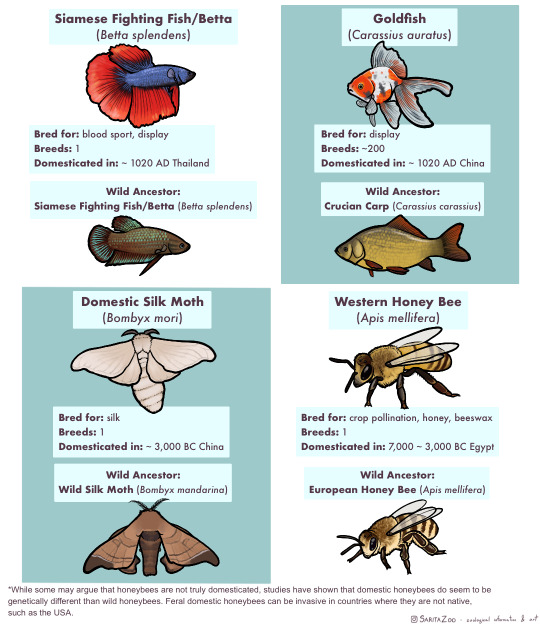

Phew. This one took, uh… a bit longer than expected due to other projects both irl and art-wise, but it’s finally here. The long-awaited domestic animal infographic! Unfortunately, I didn’t have enough space to cover every single domestic animal (I’m so sorry, reindeer and koi, my beloveds) but I tried to include as many of the “major ones” as possible.
I made this chart in response to a lot of the misunderstandings I hear concerning domestic animals, so I hope it’s helpful!
Further information I didn’t have any room to add or expand on:
🐈 “Breed” and “species” are not synonyms! Breeds are specific to domesticated animals. A Bengal Tiger is a species of tiger. A Siamese is a breed of domestic cat.
🐀 Different colors are also not what makes a breed. A breed is determined by having genetics that are unique to that breed. So a “bluenose pitbull” is not a different breed from a “rednose pitbull”, but an American Pitbull Terrier is a different breed from an American Bully! Animals that have been domesticated for longer tend to have more seperate breeds as these differing genetics have had time to develop.
🐕 It takes hundreds of generations for an animal to become domesticated. While the “domesticated fox experiment” had interesting results, there were not enough generations involved for the foxes to become truly domesticated and their differences from wild foxes were more due to epigenetics (heritable traits that do not change the DNA sequence but rather activate or deactivate parts of it; owed to the specific circumstances of its parents’ behavior and environment.)
🐎 Wild animals that are raised in human care are not domesticated, but they can be considered “tamed.” This means that they still have all their wild instincts, but are less inclined to attack or be frightened of humans. A wild animal that lives in the wild but near human settlements and is less afraid of humans is considered “habituated.” Tamed and habituated animals are not any less dangerous than wild animals, and should still be treated with the same respect. Foxes, otters, raccoons, servals, caracals, bush babies, opossums, owls, monkeys, alligators, and other wild animals can be tamed or habituated, but they have not undergone hundreds of generations of domestication, so they are not domesticated animals.
🐄 Also, as seen above, these animals have all been domesticated for a reason, be it food, transport, pest control, or otherwise, at a time when less practical options existed. There is no benefit to domesticating other species in the modern day, so if you’ve got a hankering for keeping a wild animal as a pet, instead try to find the domestic equivalent of that wild animal! There are several dog breeds that look and behave like wolves or foxes, pigeons and chickens can make great pet birds and have hundreds of colorful fancy breeds, rats can be just as intelligent and social as a small monkey (and less expensive and dangerous to boot,) and ferrets are pretty darn close to minks and otters! There’s no need to keep a wolf in a house when our ancestors have already spent 20,000+ years to make them house-compatible.
🐖 This was stated in the infographic, but I feel like I must again reiterate that domestic animals do not belong in the wild, and often become invasive when feral. Their genetics have been specifically altered in such a way that they depend on humans for optimal health. We are their habitat. This is why you only really see feral pigeons in cities, and feral cats around settlements. They are specifically adapted to live with humans, so they stay even when unwanted. However, this does not mean they should live in a way that doesn’t put their health and comfort as a top priority! If we are their world, it is our duty to make it as good as possible. Please research any pet you get before bringing them home!
#phew#hopefully that’s it for now unless I see more tags I feel really need addressed#if anyone has any questions though my ask box is open!#long post#SaritaZoo#Domestic animals#domestication
38K notes
·
View notes
Text
Dual Skill Advantage: CCNA + Python Training in Chandigarh
In today’s tech-centric world, employers no longer seek individuals with just one skill. Instead, they prioritize candidates who can adapt, troubleshoot networks, automate tasks, and contribute to various aspects of IT infrastructure. This is where the combination of CCNA and Python training becomes a powerful asset. If you're planning to begin a rewarding career in networking or IT, gaining dual expertise through CCNA + Python Training in Chandigarh could be your smartest move yet.
Why Combine CCNA and Python?
Traditionally, the world of IT and networking has been segmented—network engineers specialized in managing hardware and protocols, while programmers focused on software development. But with the advent of Network Automation, these roles are converging.
Cisco itself has updated its CCNA certifications to include knowledge of automation and programmability, recognizing Python as the leading language for these tasks. When you combine CCNA training with Python programming, you position yourself at the forefront of this evolving trend. You gain the ability to not only configure and manage networks but also write scripts that automate these processes, saving time, reducing human error, and increasing efficiency.
What is CCNA?
CCNA (Cisco Certified Network Associate) is a globally recognized certification provided by Cisco Systems. It validates your ability to install, configure, operate, and troubleshoot medium-size routed and switched networks.
Key topics covered in CCNA include:
IP addressing and subnetting
Routing and switching concepts
VLANs and trunking
WAN technologies
Network security fundamentals
Network automation and programmability
The CCNA certification acts as a strong foundation for a variety of networking careers, including Network Administrator, Network Engineer, and Systems Administrator.
Why Learn Python?
Python is one of the most versatile and beginner-friendly programming languages. It's widely used in various fields such as web development, data science, artificial intelligence, and increasingly, in network automation.
Here’s what makes Python ideal for network engineers:
Simple and readable syntax
Extensive libraries for network automation (e.g., Netmiko, NAPALM)
Integration with APIs and third-party tools
Support for DevOps tools and methodologies
Community-driven support and documentation
Learning Python gives you the power to automate repetitive tasks, parse network logs, interact with APIs, and create network-aware applications. This adds enormous value to your profile in the job market.
Why Chandigarh?
Chandigarh is rapidly emerging as a hub for technical education and professional training in North India. With a range of quality institutes, access to qualified mentors, and industry-aligned curriculum, the city has become a hotspot for IT aspirants.
Whether you're a student, a working professional, or someone planning a career switch, enrolling in a structured training program in Chandigarh provides the ideal environment to grow.
The Dual Skill Advantage Explained
Now let’s explore the combined benefits of enrolling in CCNA Training in Chandigarh along with Python Training in Chandigarh.
1. Better Career Opportunities
While CCNA alone prepares you for roles like Network Engineer or IT Support Specialist, adding Python allows you to apply for more advanced roles such as:
Network Automation Engineer
DevOps Engineer
Systems Integration Specialist
Cloud Infrastructure Engineer
Recruiters are increasingly favoring candidates who can manage both hardware and scripting tasks.
2. Higher Salary Packages
As per industry standards, professionals with both networking and programming skills tend to command higher salaries. Dual-skilled individuals are seen as strategic assets in organizations aiming to scale and automate their IT operations.
3. Relevance to Modern Network Infrastructure
Today’s networks are highly dynamic and cloud-based. Manual configuration is becoming obsolete. Python empowers you to automate device provisioning, gather network telemetry data, and make data-driven decisions faster.
4. Smooth Transition to DevOps and Cloud
If you’re eyeing a future in DevOps or Cloud Engineering, Python knowledge becomes essential. Combining it with CCNA allows for a smoother transition, as you already understand networking essentials and automation principles.

Industry Demand for Dual-Skilled Professionals
The demand for professionals with both networking and scripting knowledge is growing across various sectors:
Telecom companies rely on automated scripts to manage large-scale infrastructure.
IT consultancies need professionals to design, implement, and automate custom network solutions.
Cloud providers like AWS, Google Cloud, and Azure favor engineers with a grasp of infrastructure coding (Infrastructure as Code).
Enterprises with hybrid networks prefer professionals who can maintain both traditional and modern IT frameworks.
Where to Learn: CCNA and Python Training in Chandigarh
To make the most of this dual skillset, it’s essential to choose a reliable and experienced training provider. One such option is CCNA Training in Chandigarh offered by CBitss®, a reputed institute with a proven track record in networking education.
CBitss® provides:
Real-time lab access
Cisco-certified instructors
Updated curriculum based on the latest Cisco syllabus
Hands-on troubleshooting and case studies
Simultaneously, their Python Training in Chandigarh covers:
Basics to advanced Python concepts
Scripting for network automation
Real-world mini-projects
Training aligned with CCNA for seamless integration
By enrolling in both programs, you get a comprehensive learning experience designed to meet modern job market demands.
Who Should Enroll in CCNA + Python Training?
This dual program is ideal for:
Fresh Graduates aiming to enter the IT field with a competitive edge.
Working Professionals in networking roles who want to shift to automation or DevOps.
Software Developers looking to expand their horizons into networking.
Career Switchers seeking a fresh start with high-demand skills.
Tips to Maximize Your Learning
To succeed in your CCNA + Python journey:
Practice Daily: Lab practice for CCNA and coding exercises for Python are both crucial.
Work on Projects: Try creating Python scripts to automate network tasks. Start small and gradually build complexity.
Use Cisco Packet Tracer or GNS3: These simulators are great for testing your CCNA knowledge.
Participate in Forums: Sites like Stack Overflow, Cisco Learning Network, and GitHub offer insights and problem-solving opportunities.
Stay Updated: Follow tech trends, attend webinars, and read blogs to remain aware of how networking and automation evolve.
Final Thoughts
The tech industry is changing rapidly, and staying ahead means adapting to hybrid roles and multi-skill demands. A combination of CCNA and Python training equips you with both the operational understanding of networks and the programming skills needed to automate and optimize them. This dual-skill path opens doors to lucrative job opportunities and long-term career stability.
If you're in Chandigarh and looking to take a proactive step towards future-proofing your IT career, CCNA + Python training is the way to go.
#CCNA Training in Chandigarh#CCNA Course in chandigarh#Python Training in Chandigarh#python course in chandigarh
0 notes
Text
What is BCA (Bachelor of Computer Application)? What’s the scope of it?

With the advent of the digital age, computers have become omnipresent, from apps and websites on mobiles to smart devices and virtual assistants. There is the magic of computer programs working behind it all, and the people creating and maintaining them are in top demand. If you are someone who is fascinated to know how technology functions and wishes to create a secure and engaging career in the IT sector, then the BCA course is ideal for you.
Among the finest institutions to follow this path is Usha Martin University, situated at the center of Jharkhand. Famous for its contemporary education system, experiential learning style, and welcoming environment for students, the university has a well-designed Bachelor of Computer Application program that provides students with the appropriate skills and confidence to enter the professional world.
What is the BCA Course?
The BCA is a three-year undergraduate course. The program is for those who are eager to get deeper into the information technology sector. The curriculum covers various subjects, including programming languages, software development, web design, networking, database management, cloud computing, and data analytics. It teaches students the how and why of a computer application, ranging from the back-end codes to the front-end user interface.
The course of BCA is a mirror image of a B.Tech in Computer Science but with greater emphasis on software development and application development compared to hardware. It’s perfect for students who are more interested in coding programs, developing apps, creating real-life technology solutions, and designing new digital tools.
Subjects Covered in the BCA Program
The Bachelor of Computer Application course is meant to develop your IT skills gradually. Some of the topics covered in the three years are
Computer Fundamentals
Programming in C, C++, Java, and Python
Data Structures
Web Technologies (HTML, CSS, JavaScript, PHP)
Database Management System (DBMS)
Operating Systems
Computer Networks
Software Engineering
Mobile Application Development
Artificial Intelligence
Cloud Computing
Due to course details like these, students have in-depth knowledge and can fit into different profiles in the IT sector.
BCA Course Eligibility Criteria
Applicants must have done their 10+2 from an accredited board with math as a required subject.
They should have at least 50% marks in their higher secondary education.
BCA Course Duration
The duration of the BCA course is three years, broken up into six semesters at Usha Martin University.
Career Prospects After BCA
BCA provides an entry to many varied career opportunities in the field of IT. Some of the sought-after jobs that BCA graduates can pursue are
Software Developer
Web Developer
Mobile App Developer
System Analyst
Database Administrator
Network Engineer
IT Support Specialist
Data Analyst
UI/UX Designer
Digital Marketing Executive (with technical skills)
With experience and additional education, many students even end up becoming project managers, product developers, and startup entrepreneurs. The world’s your limit if you’re dedicated and passionate.
Scope of the BCA Course
The scope of a Bachelor of Computer Application is huge and ever-expanding. With the growth of digital transformation in every sector—banking, education, healthcare, retail, media—there is a massive need for competent IT professionals.
Additionally, students who have earned the BCA can also opt for further studies such as MCA (Master of Computer Application), MBA in IT, or specialized data science, cloud computing, ethical hacking, or artificial intelligence certifications.
Remote and freelancing job opportunities are also on the rise, particularly for jobs such as web development, software testing, or mobile application development. BCA graduates can also make good money by working on freelance projects or opening their own computer application ventures.
BCA Course in Jharkhand—An Emerging Hub of IT Education
Jharkhand is developing very fast with regard to education and infrastructure facilities. The BCA program in Jharkhand is becoming popular among students who desire quality education near their home. Usha Martin University is leading the change by providing standard education at a reasonable price.
With increasing numbers of companies setting up offices in Ranchi and adjoining cities and the development of IT parks and technology hubs, students of Usha Martin University are in the correct location at the correct time. They have the potential to fully utilize internships, industry visits, job fairs, and startup events.
Why Study at Usha Martin University for the BCA course?
In case you plan to take the BCA course in Jharkhand, then Usha Martin University (UMU) is a must-consider option. Here’s why:
Industry-Specific Syllabus: Usha Martin University regularly revises its syllabus based on the latest requirements of the industry. The course curriculum for the BCA course is in line with the current trends of the IT sector. The students do not just learn general programming but also advanced topics like artificial intelligence, machine learning, and cybersecurity.
Experienced Faculty: The university has a team of experienced professors and industry professionals who guide students at every step. Because of course details explained by these mentors, students gain a strong foundation and practical understanding.
Hands-on Learning: Theory alone isn’t enough in the field of computer science. Usha Martin University provides students with plenty of opportunities for hands-on experience through lab sessions, projects, internships, and workshops. This builds their problem-solving skills and prepares them for real jobs.
State-of-the-Art Infrastructure: UMU has advanced computer laboratories, intelligent classrooms, and an e-library. With high-speed internet access and the most advanced software tools, students can quickly rehearse and develop their own computer application projects.
Placement Support: The university is tied up with leading IT companies. Proper training for resume preparation, interviewing, and mock interviews is provided to the students. Many students secure jobs in well-known tech firms, startups, and multinationals every year.
Conclusion
In short, the BCA course is the right choice for students who have a passion for computers, enjoy problem-solving, and wish to establish a prosperous career in the fast-evolving world of technology. The Bachelor of Computer Application is more than a degree; it’s a ticket to exciting professions, innovative possibilities, and a future-proof career.
Selecting Usha Martin University as your BCA destination is a wise choice. With experienced faculty, good placement opportunities, state-of-the-art infrastructure, and a real-world learning focus, the university prepares you for the professional arena with confidence.
Usha Martin University is the choice for the best BCA course in Jharkhand, where your technology future takes off.
#bca course#bca degree#bca programs#bca course in jharkhand#top bca college in ranchi#bca course admission#bca computer application#bca degree course#bca course ranchi#bca admission 2025#bachelor degree
0 notes
Text
Data Science Evolution over the Decades and Future Advances
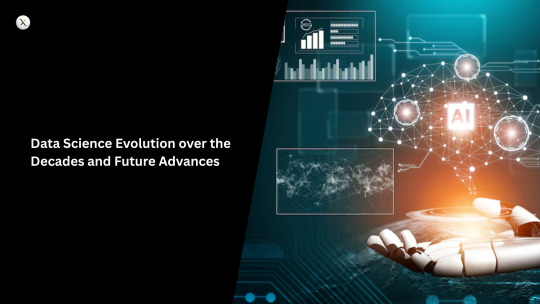
From humble beginnings rooted in statistics and early computing, data science has undergone a phenomenal transformation, evolving into one of the most impactful and sought-after fields of the 21st century. It's a journey marked by an exponential surge in data, relentless technological innovation, and a growing understanding of data's power to drive decisions and reshape industries.
Let's take a stroll through the decades and peek into the exciting future of this dynamic discipline.
The Early Days: The 1960s to 1990s - The Genesis
While the term "data science" itself gained prominence later, its foundational concepts were laid in the mid-20th century.
1960s-1970s: The Dawn of Data Analysis: Statisticians like John Tukey began advocating for "data analysis" as a distinct field, emphasizing exploratory techniques and the visual representation of data. This era saw the initial intersection of statistics and computer science, laying the groundwork for what was to come.
1980s-1990s: Data Mining Emerges: As businesses started accumulating larger datasets, the need for automated pattern recognition grew. This period witnessed the rise of "data mining," leveraging statistical methods and early machine learning algorithms to uncover hidden insights in structured data. Relational databases became the norm, and early tools for reporting and querying data emerged.
The Big Data Boom: The 2000s - The Unstructured Challenge
The turn of the millennium brought a seismic shift: the explosion of digital data.
The "Big Data" Era: The proliferation of the internet, social media, and digital transactions led to unprecedented volumes, velocities, and varieties of data (the 3 V's). Traditional data processing methods struggled to cope.
Hadoop and MapReduce: This decade saw the advent of groundbreaking technologies like Hadoop (for distributed storage) and MapReduce (for processing large datasets). These open-source frameworks became critical for handling the sheer scale of "big data," allowing for the analysis of both structured and unstructured information.
Coining the "Data Scientist": Recognizing the unique blend of skills required to navigate this new data landscape – statistics, computer science, and domain expertise – the term "data scientist" began to gain traction, eventually popularized by the Harvard Business Review in 2012 as "the sexiest job of the 21st century."
The Machine Learning Revolution: The 2010s - Prediction Takes Center Stage
This decade truly ignited the data science phenomenon, largely driven by advancements in machine learning.
Machine Learning Mainstream: Algorithms for prediction and classification, once confined to academic research, became widely accessible. Supervised and unsupervised learning techniques, like decision trees, support vector machines, and clustering, found widespread application across industries.
Deep Learning Breakthroughs: Towards the latter half of the decade, deep learning, a subset of machine learning powered by neural networks, achieved remarkable success in areas like image recognition, natural language processing, and speech synthesis, pushing the boundaries of what AI could achieve.
Cloud Computing & Democratization: The rise of cloud platforms (AWS, Azure, Google Cloud) provided scalable and affordable infrastructure for data storage and processing, democratizing data science and making advanced analytics accessible to a broader range of organizations.
Open-Source Dominance: Python and R emerged as the dominant programming languages for data science, fueled by rich ecosystems of open-source libraries (e.g., scikit-learn, TensorFlow, PyTorch, Pandas).
The Present & Near Future: Late 2010s to Mid-2020s - Specialization and Responsibility
Today, data science is characterized by increasing specialization and a stronger focus on ethical considerations.
AI Data Scientist: The emergence of specialists focusing on the entire AI model lifecycle, from advanced model architecture design to ethical deployment.
MLOps Maturation: The industrialization of machine learning model deployment and management (MLOps) is becoming crucial for ensuring models are reliable, scalable, and perform well in production.
Explainable AI (XAI): As AI models become more complex, the need to understand their decisions and ensure transparency is paramount. XAI techniques are gaining importance.
Responsible AI and Ethics: Growing awareness of algorithmic bias, fairness, and data privacy has led to a stronger emphasis on ethical AI development and data governance frameworks (like GDPR).
Real-time Analytics: The demand for instant insights from streaming data, driven by IoT and real-time business needs, is pushing the boundaries of data processing.
Augmented Analytics & AutoML: Tools that leverage AI to automate parts of the data analysis process, making data insights more accessible to "citizen data scientists" and allowing experts to focus on higher-value tasks.
Future Advances: 2025 and Beyond - The Next Frontier
The trajectory of data science promises even more revolutionary advancements:
Generative AI Proliferation: Beyond current large language models, generative AI will revolutionize content creation, drug discovery, material science, and personalized experiences, moving from experimentation to widespread production deployment.
Edge AI: Processing data closer to its source (on devices, at the "edge" of the network) will become increasingly common, enabling real-time decision-making in autonomous vehicles, smart cities, and industrial IoT.
Quantum Computing's Impact: While still in its nascent stages, quantum computing holds the potential to solve currently intractable data-intensive problems, accelerating complex simulations and optimization tasks.
Data Mesh and Data Products: Organizations will move towards more decentralized data architectures, treating data as a product with clear ownership and consumption patterns, enhancing data accessibility and quality.
Synthetic Data Generation: As privacy concerns grow and real-world data collection faces limitations, the generation of high-quality synthetic data for training AI models will become a vital capability.
Human-AI Collaboration: The future isn't about AI replacing humans, but about intelligent systems augmenting human capabilities, freeing up data scientists for more strategic, creative, and ethical considerations.
Hyper-Personalization at Scale: With more sophisticated data and AI, truly individualized experiences across healthcare, education, retail, and entertainment will become the norm.
Data science has come a long way, transforming from a niche academic pursuit into a pivotal force driving innovation across every sector. The journey has been thrilling, and as we look ahead, the potential for data to continue reshaping our world is boundless. The future of data science is not just about crunching numbers; it's about building a more intelligent, efficient, and ultimately, a better future.
0 notes